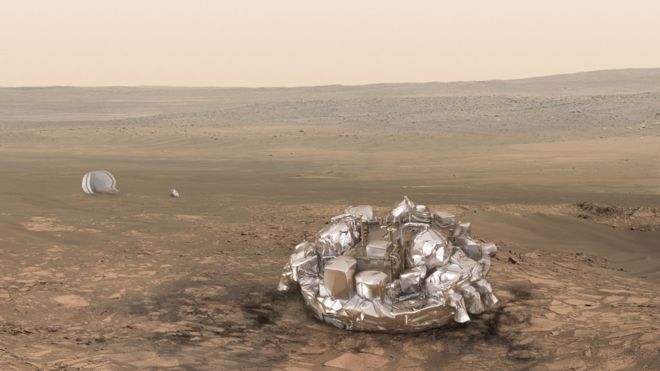Schiaparelli Mars probe `ready for all eventualities`

US researchers have suggested sand particles could soon start lifting into the atmosphere - something they do on a regular, seasonal basis.
But the European Space Agency says it is unconcerned. Indeed, some scientists are even excited at the prospect.
“We always knew we could arrive in a dust storm and Schiaparelli was designed with that possibility in mind,” said Esa project scientist, Jorge Vago.
“And from the point of view of getting data on the electrification of dusty atmospheres, it could be very nice,” he told BBC News. Schiaparelli is carrying to Mars the first ever instrument dedicated to this purpose.
The US space agency put out a release last week that raised the idea of an imminent storm, noting it could eventually evolve into the type that envelops the whole globe. In truth, it is unlikely to get that big for many weeks - if at all.
But, irrespective of timescales, European engineers insist they are prepared. A lot of dust in the Martian air would increase abrasion on Schiaparelli’s entry heatshield and on the big parachute it will use to slow the fall to Meridiani. All this has been tested in advance on Earth.
Likewise with any associated strong winds - the plain is wide enough and flat enough to accommodate an off-centre landing.
“The only thing it could affect is the images we take on descent,” explained flight director Michel Denis. “If it’s too dusty we might not be able to see the surface so well.”
Schiaparelli is a 600kg demonstrator - a trial of procedures and technologies needed to land on the Red Planet. Europe’s only previous attempt to land on Mars was short-lived. Its 2003 Beagle-2 effort failed to deploy properly after touching down, subsequent satellite pictures revealed.
Schiaparelli will hope to fare better, albeit with a planned surface operation of only a few days.
The probe is part of Esa’s ExoMars programme to explore the Red Planet and search for signs of past or present life. The other parts of the project include Schiaparelli’s “mothership”, called the Trace Gas Orbiter.
Once this satellite has dropped off the Italian-built entry module, it will remotely investigate Mars’ atmosphere and geology.
The final part of ExoMars is a UK-assembled robot rover, to be delivered to the planet’s surface in 2021.
Key elements of Schiaparelli will be replicated in the platform that places the six-wheeled vehicle on the ground.
This includes all the algorithms for guidance, navigation and control (GNC), as well as the doppler radar which determines the distance to the ground. "With the GNC and the radar, we will be carrying over the ‘brains’ of the Schiaparelli, if you like,” explained Vincenzo Georgio from aerospace prime contractor Thales Alenia Space.
Schiaparelli and Beagle-2 have little in common. For one thing they use very different technology to make the final approach. Beagle relied on bouncing airbags to cushion its moment of impact; Schiaparelli will use retro-rockets to bring it to a hover above the surface before then belly-flopping from two metres. A crushable underside will soften the dump-down.
One instrument has been carried over, however. A wind sensor that was on Beagle is flying again in Schiaparelli’s package of environmental instruments. “I’ve been waiting 13 years for this data,” said Colin Wilson from Oxford University.
The British scientist is another of those researchers who would be quite keen to see conditions start to whip up ahead of landing.
“For me the most exciting thing would be being on the edge of a dust storm when the front comes over. That`s when you`d get the biggest wind gradients and biggest turbulence,” he told BBC News.
The Trace Gas Orbiter will eject Schiaparelli this Sunday on a direct path to encounter Mars on the Wednesday. Assuming its heathsield, parachute and rockets do their job, the probe should land on Meridiani Plain at 14:48 GMT (15:48 BST; 16:48 CEST).
The current distance between Earth and Mars (167 million km; 104 million miles) means there is a light-travel time for any radio signal of over nine minutes. So, Esa will know they have a successful landing if they are continuing to receive a UHF transmission from the probe at the top of the hour.
That UHF transmission - simple tones, but no telemetry - will be picked up by the Giant Metrewave Radio Telescope (GMRT) near Pune, in India, and relayed to the European Space Operations Centre (mission control) in Darmstadt, Germany.
A fuller telemetry report from Schiaparelli will wait on a pass overhead from Nasa’s Mars Reconnaissance Orbiter some hours later.
A successful landing will give a much-needed boost to the ExoMars programme which has struggled for many years with its schedule and budget.
Project managers would like to go into a key meeting of Esa member states in November to report not only that Schiaparelli performed as designed but that the latest revisions to the rover plans will also deliver a solid mission.
"It`s the last big council meeting before the ministerial in December and we want to come out of that meeting with flying colours," said Dr Vago.















-1741770194.jpg&h=190&w=280&zc=1&q=100)






-1741765030.jpg&h=190&w=280&zc=1&q=100)
























